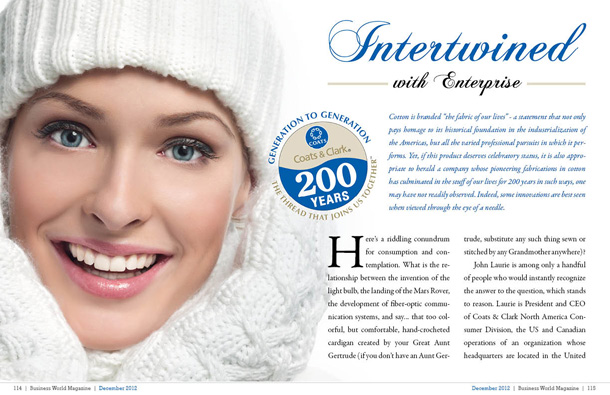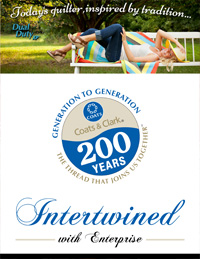


Cotton is branded “the fabric of our lives†– a statement that not only pays homage to its historical foundation in the industrialization of the Americas, but all the varied professional pursuits in which it performs. Yet, if this product deserves celebratory status, it is also appropriate to herald a company whose pioneering fabrications in cotton has culminated in the stuff of our lives for 200 years in such ways, one may have not readily observed. Indeed, some innovations are best seen when viewed through the eye of a needle.
Here’s a riddling conundrum for consumption and contemplation. What is the relationship between the invention of the light bulb, the landing of the Mars Rover, the development of fiber-optic communication systems, and say… that too colorful, but comfortable, hand-crocheted cardigan created by your Great Aunt Gertrude (if you don’t have an Aunt Gertrude, substitute any such thing sewn or stitched by any Grandmother anywhere)?
John Laurie is among only a handful of people who would instantly recognize the answer to the question, which stands to reason. Laurie is President and CEO of Coats & Clark North America Consumer Division, the US and Canadian operations of an organization whose headquarters are located in the United Kingdom. Coats plc is the world’s leading manufacturer and supplier of sewing materials such as threads, yarns and an amazingly-long string of other innovations spun among the works of many industries.
Laurie, a graduate of the general management program at Harvard Business School, is quick to acknowledge that what primarily sets Coats & Clark apart from the fray of would-be competitors is “the strength and heritage of the brandâ€. To fully appreciate the deep history and diversity of this particular organization, it is important to first account of the processes and products which it has pioneered.
A Stitch in Time
The weaving together of Coats & Clark lingers through the looms of yesteryear, all the way back to the early 1800s in Paisley, Scotland. During this era, weavers had begun to reproduce more affordable versions of the silken-styled Kashmir shawls so popular in the fashion sensitivities of India. Operations hit a snag by way of Napoleon Bonaparte who enforced a blockade on Great Britain, a move that effectively prevented the importing of goods, including requisite silk, which was used in all the sewing mills of that era.
Necessity is said to be the mother of invention, and to that degree, an idea spawned in the minds of two brothers, James and Patrick Clark. These Scotsmen pioneered a new method of twisting strands of cotton to produce a thread so smooth and so durable, it was soon deemed as the perfect substitute to silk. By 1812, the Clarks had devised a way to produce 3-ply cotton thread and were well on their way to opening their first factory for the manufacturing of that which would go on to thrillingly thread its way into commercial mills, as well as the homes of hand-sewn hobbyists.
The flourishing of their factory was duly noted by another Scotsman from Paisley named James Coats. A skilled weaver who worked with yarns, Coats went on to create his own enterprise in 1826 which prospered and was ultimately passed down to his sons, James and Peter. Over the following years, the Clark Thread Company and J. & P. Coats emerged as the strongest force in terms of driving their market and meeting consumer demands. The Clarks invented a machine for spinning thread onto wooden spools, which standardized a mode of delivery that still stands today. There was also John Clark who created O.N.T. (Our New Thread) a six cord thread which helped pave progression for the sewing machines invented by Elias Howe. Whereas sewing had been solely by-hand, O.N.T. proved convenient for these machines which revolutionized the industry. Meanwhile, the Coats had begun marketing their products by creating display cases and specialty cabinets for the sale or collection of sewing materials which made their way among merchants throughout the world. The Coats built their first box factory in Pawtucket, Rhode Island, in 1877. A string of successes followed for both and, as fate would have it, they ultimately elected to bind their futures and fortunes together by establishing an organization that is recognized today as Coats & Clark.
For a company with such a long heritage it is no surprise that they have been at the heart of so much. For instance, when Thomas Edison invented the light bulb, their thread was used in experiments as a filament to generate light. And, when NASA dropped a surveillance module on the planet of Mars, it was this company’s thread that was used in the deployment of the airbags that cushioned the device’s descent onto the surface. The fiber-optic communication systems that transmit vast terabytes of data at the speed of light, these too require such threads to protect them from moisture damage. The list goes on and on. Their thread can even be found on that brewable little bag used to concoct your favorite cup of tea. Therefore, it is no mere pun when John Laurie says Coats & Clark has been “steeped in innovation.â€
Yet, for all the complex applications that Coats & Clark products fulfill, there are some that still remain as simple and familiar as the Red Heart Super Saver yarn or spool of Dual Duty XP thread sold daily at stores like Walmart, Michael’s, Hobby Lobby, Joann Fabrics, and more, throughout THE WORLD. Laurie refers to this thread as “the backbone of the business.â€
The Darning Dynamics
When considering this enterprise which arose within an era of Napoleonic conquest, there will be some who assert similar dreams of world domination still pervade among its practices. Laurie isn’t casually unraveling threads of intention in admitting, “We want to continue to be the leading global textile craft company in the world… we’re already the largest, but I mean leading the market … to be the one competitors look at with envy.â€
The focus, like any successful enterprise, involves looking at what are we doing today, how do we do it better and how are we preparing to meet the challenges of tomorrow? In this extent, Coats & Clark offers examples from which all can learn.
For one, this is a company that constantly monitors and measures market trends, on a global scale, and to such a degree that they can effectively anticipate change before it fully occurs, thereby capitalizing on it more rapidly. Laurie says this is accomplished, in large part, through the long reach of their relationships and communications with retailers throughout the world. He also credits their participation in international trade fairs, conducting consumer studies and empowering the company’s product development team, which all combines to help them maintain, as Laurie indicates, “a finger on the pulse.â€
Their analysis of external matters may only be outmatched by the emphasis they place on measuring and monitoring internally. This, in itself, involves constant communication with staff at all levels of engagement. In fact, when it comes to the surveys used to elicit employee suggestions and feedback on workplace issues, Coats & Clark achieves participation rates which are well above industry averages.
Their training practices do not only involve the safe operation of equipment through all operations, but also include workshops on ethics and principled professionalism.
And by being part of a global organization driving economic development in communities throughout the world, Coats & Clark has drawn strength through the sheer diversity of the more than 20,000 people employed, that encompass all aspects of ethnicity, gender, orientation and age.
Here in America, where economic fluctuations continue to be the fixation of so many, there are some 800 employees that benefit, right along with the communities in which they live, because Coats & Clark maintains a presence here. This includes mills and distribution operations located in communities of Georgia and the Carolinas. Laurie observes, “Many textile operations have moved their sourcing offshore, but we still manufacture here… a large percentage of what we sell is made in America.â€
The American composite of corporate culture includes many 2nd and 3rd generation staff from the same families, backing up Laurie’s assertion that many workers and their families have been integral to the industry “for a very long time.â€
“There is a great team spirit within our employees too which makes them a large part of our success. They are innovative, hardworking and I would put our efficiencies up against any textile operation anywhere in the world,†says Laurie with complete confidence.
Furthermore, while working to increase the bottom line, the company has been equally engaged in acting as a responsible corporate citizen. This includes measures such as reducing its carbon footprint, enacting environmental protocols which, in recent years, have allowed their facilities to reduce emissions of Greenhouse gases as well as their consumption of water through the incorporation of reverse osmosis filtration systems.
As they strive to improve their own inner workings, Coats & Clark continues to innovate. They annually introduce new colors of yarn and fabrics to the market as well as new concepts, such as their retro-reflective thread that can be used in embroidery to spectacular effect in low light or at night. At same time, they develop and bring to market new products such as ‘Phoomph’, a product which affixes fabric to a backing without use of an iron.
But behind all these innovative accomplishments, Laurie says there is an awareness of both quality and trust that consumers depend-on and demand. “There is a very strong positive emotion between the brands consumers are using today, and that which was used by their mothers and grandmothers,†he says. The significance of their service in this sense of family tradition is not something taken for granted as it fortifies their functions, role and responsibility in being, as Laurie calls it, “the heritage of the brand.â€
Coats & Clark will, no doubt, continue to reign in a kingdom of their own making, never resting on their nobility or notability, introducing new and innovative products and improving performance, constantly signifying the superiority that sets them apart as the leading textile craft player.







